Please Take Note: This is a review of the final game, but it might change slightly based on the success of the Kickstarter campaign. The game is being reviewed on the components and the rules provided with the understanding that “what you see is not what you might get” when the game is published. If you like what you read and want to learn more, we encourage you to visit the Kickstarter campaign. Now that we have all that disclaimer junk out of the way, on with the review.
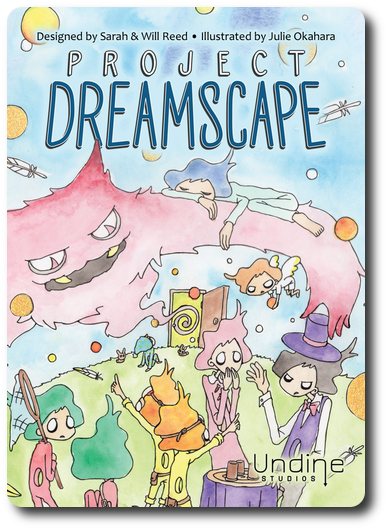
The Basics:
- For ages 7 and up (publisher suggests 10+)
- For 2 to 4 players
- Approximately 30 minutes to complete
Geek Skills:
- Counting & Math
- Logical & Critical Decision Making
- Reading
- Pattern/Color Matching
- Strategy & Tactics
- Hand/Resource Management
Learning Curve:
- Child – Easy
- Adult – Easy
Theme & Narrative:
- When you are sleeping, dreams are your reality
Endorsements:
- Gamer Geek approved!
- Parent Geek approved!
- Child Geek approved!
Overview
Between the state of begin awake and our deepest slumber, the realm of dreams can be found. Scientists have invented a machine that can now measure, observe, and record our dreams, but the machine is not yet ready for release. Test subjects are needed to help discover flaws in the system. You have been selected to help test the machine and make history, but there is a catch. The dream recording machine will not let you wake up once the test begins. Pray for sweet dreams because you won’t be able to escape your own nightmares.
Project Dreamscape, designed by Sarah Reed, Will Reed, and to be published by Undine Studios, is comprised of 52 Sleep cards. The illustrations by Julie Okahara are whimsical and highly stylized, supporting the game’s theme, as well as furthering the overall narrative. As this is a review of a prepublished game, I will not comment on the game’s component quality.
Getting Ready for Bed
To set up the game, take all 52 Sleep cards and shuffle them. This is the Sleep draw deck for the duration of the game.
Second, deal 1 Sleep card to each player, face-down. This is the player’s first “Z card” (as in “Zzzzz”) and it SHOULD NOT be looked at. All Z cards remain face-down and represent currency in the game. This first Z card starts the player’s Deep Sleep stack, which we will discuss further in a moment. Players should leave room next to their Deep Sleep stack for additional cards that will form their REM stack.
Third, place the Sleep draw deck in the middle of the playing area, making sure to leave room for a discard pile. Draw 5 cards, placing them in a row next to the Sleep draw deck, face-up. Place the first card next to the deck, the following card goes next to the first card and so on until all 5 Sleep cards are drawn and placed in the row. The Sleep cards in the row are referred to as Dream cards and the row of Dream cards is referred to as the Dreamscape.
When completed, your set up might look similar to the following image.
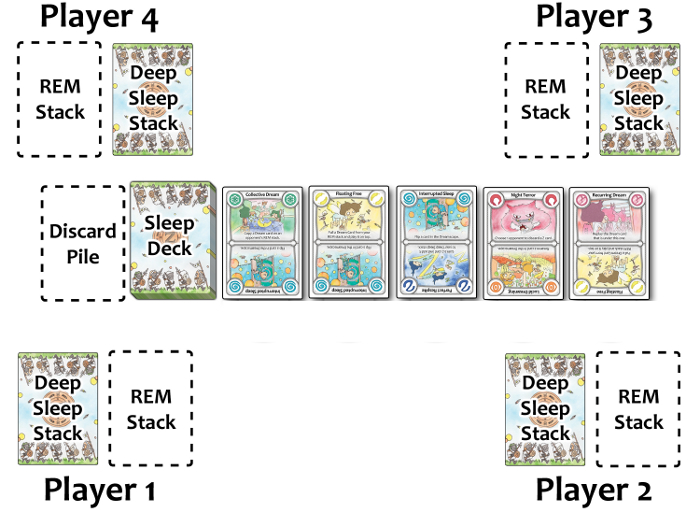
That’s it for game set up. Determine who the first player will be and begin.
The Nature of Dreams
Even though Project Dreamscape is comprised of just 1 card, the game rules make reference to multiple card type. If you look through the card deck, you won’t find these cards. When playing the game, where the cards are played will alter their properties. Thematically speaking, this represents the ever-shifting nature of dreams and the creativity of the subconscious mind.
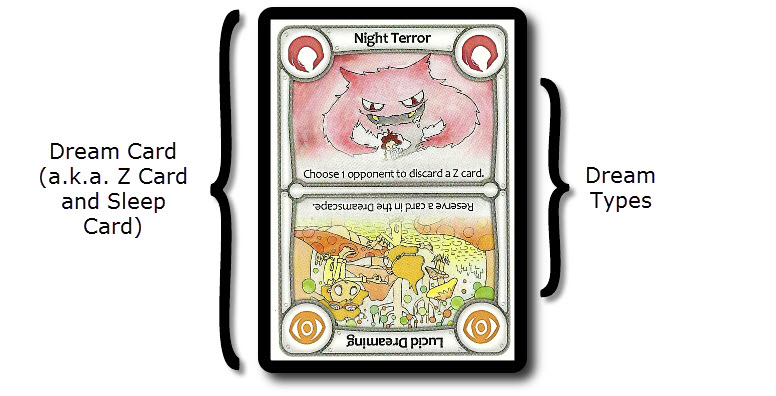
Sleep Cards and the Sleep Draw Deck
This is the default state of the cards in the game. Sleep cards remain face-down and come from the Sleep draw deck. Once they are taken from the Sleep draw deck, they change into a different type of card. It’s best to think of Sleep cards are untapped potential. The stuff of dreams can be molded and shaped into whatever the player likes. As such, it is the starting point for everything in the game.
Z Cards and the Deep Sleep Stack
The Z card is nothing more than a Sleep card played face-down to the Deep Sleep stack from the Sleep draw deck. The Deep Sleep stack was created during game set up. Z cards are used like currency in the game. The more Z cards the player has, the deeper their sleep. The deeper the sleep, the more powerful the dream. However, Z cards are a double-edge sword…or pillow, to keep with the dream motif. Z cards will count as negative points at the end of the game. Players are welcome to count the number of Z cards in their Deep Sleep stack whenever they like, but they can never look at the face of the Z cards.
Dream Cards, Dream Types, the Dreamscape, and the REM Stack
A Dream card is a Sleep card, but face-up and placed in the Dreamscape. Here the Dream card will remain until it is taken and added to a player’s REM stack. A REM stack, which sits next to the player’s Deep Sleep stack, represents the dreams the player is having. Which is why the cards are face-up. Each Dream card is made of 2 Dream types, acknowledging the fact that the subconscious mind is very difficulty to understand. Within the game, Dream types provide the player with a special action that is resolved during game play before the Dream card is placed on the REM stack.
Let’s just pause a moment and let all this soak in. It’s not nearly as confusing as it sounds since players do not refer to the cards by their name during actual game play. However, it is important to understand where cards are coming from and where they are going. Failure to do so will put the player at a serious disadvantage when attempt to formulate a strategy or make use of a tactic.
The Power of Dreams and Nightmares
Each Dream card has 2 Dream types. Each is summarized here.
Floating Free
This Dream type allows the player to look through their REM stack and take and remove 1 previously played Dream card. This Dream card is then placed on top of the REM stack and the player chooses which Dream type to use. Players can look through their REM stack, but can never rearrange the order of the Dream cards.
Interrupted Sleep
This Dream type allows the player to turn over any 1 Dream card in the Dreamscape. Essentially, this turns 1 Dream card into a Z card or a Z card into a Dream card. The price of the card is still dependent on its distance from the Sleep draw deck.
Night Terror
This Dream type thematically interrupts 1 opponent’s Deep Sleep by forcing the opponent to discard 1 Z card from their Deep Sleep stack. Players can never go below 1 Z card.
Lucid Dreaming
This Dream type allows the player to take 1 Dream card from the Dreamscape and place it in front of them. When placed, it is rotated sideways to signify that it is not available. During phase 3, the selected Dream card is rotated so it is facing upward. On the player’s next turn during phase 2, the player can purchase the Dream card for 1 point and send it to their REM stack. Z cards can also be taken from the Dreamscape and used in the same manner, except they go to the player’s Deep Sleep stack when they are paid for. There is no limit to the number of cards a player can have in front of them when using the “Lucid Dreaming” Dream type.
Perfect Respite
This Dream type allows the player to draw the topmost Sleep card from the Sleep draw deck and place it in their Deep Sleep stack. This new Z card can be used as points if the player wants to.
Recurring Dream
This Dream type allows the player to play any Dream type found on the topmost Dream card that was previously placed in the REM stack. Do no change this Dream card’s position in the REM stack.
Collective Dream
This Dream type is just like Recurring Dream, but it allows the player to select a Dream type from any Dream card on any opponent’s REM stack. The selected Dream card is not taken from the opponent and any effects to a REM stack impacts the player’s REM stack, not the opponent’s.
Shifting Dreams
This Dream type allows the player to move the Dream cards in the Dreamscape to different position. Any empty positions can be used, as well. For example, the Dream card in position “5” can be moved to position “1”. There is no limit to how many Dream cards the player can shift, but they cannot take any other action until they are done rearranging the Dreamscape.
Off to Dreamland
Project Dreamscape is played in turns with no set number of turns per game. A player’s turn consists of 3 phases, which is summarized here.
Phase 1: Deep Sleep Accumulation
The player may draw 1 Sleep card from the Sleep draw deck and, without looking at it, place it face-down in their Deep Sleep stack. Or, if the player prefers, they can skip adding any new Sleep cards to their Deep Sleep stack. Remember: Z cards in the Deep Sleep stack count as negative points at the end of the game.
Regardless if a cards was added or not, the player counts the number of Z cards in their Deep Sleep stack. The resulting number is the number of points the player can use to buy additional cards.
Phase 2: Direct Your Sleep
The player can now use the points derived from their Deep Sleep stack to acquire more cards. Specifically, dreams. This is done by buying 1 Dream card, selecting a Dream type, and then adding it to their Rem stack. This process can be repeated during this phase.
The Dreamscape is a market of sorts and all the Dream cards within it are for sale. The price of each Dream card is based on its distance to the Sleep draw deck. The closer the Dream card is to the Sleep draw deck, the more points it will cost the player to purchase.

Players must purchase at least 1 Dream card from the Dreamscape or any Dream cards that were set aside and reserved using the “Lucid Dreaming” Dream type. The player can continue to purchase Dream cards from the Dreamscape as long as they have points to spend. To help keep track of how many points are spent, rotate 1 Z card for every 1 point used. Any Z cards purchased from the Dreamscape can be used for their points immediately. Cards purchased from the Dreamscape are not replaced at this time and any remaining cards in the Dreamscape remain in their current row position.
Purchased Dream cards are placed on top and face-up on the player’s REM stack. Orientation doesn’t matter when the Dream card is placed, but the player must decide which Dream type they will use before they place it on top of their REM stack. The selected Dream type’s effects are immediately resolved if possible. If a Dream type is selected that doesn’t have an effect or cannot be used, it is simply ignored. If the Dream type selected provides the player with more Z cards, the newly acquired Z cards can be used immediately for points to purchase more Dream cards.
Then the player is done purchasing Dream cards and resolving their effects, the next phase is triggered.
Phase 3: Prepare for the Next Player
The Dreamscape is now organized. Every Dream card still in the Dreamscape is slid to the furthest position away from the Sleep draw deck and then the new Dream cards are drawn to bring the Dreamscape row back up to 5 cards. As before, place the first drawn card next to the deck, the following drawn card goes next to the first drawn card and so on until the Dreamscape has 5 cards in total. All Z cards are sent back to the player’s Deep Sleep stack.
This completest the player’s turn. The next dreamer in the turn order sequence now takes their turn starting with phase 1 noted above.
Waking Up
The game continues as described above until the Dreamscape cannot be replenished during phase 3. The game now ends and points are calculated.
First, each player calculates their Continues Dreaming score. This is done by taking all the cards in the REM stack and placing them in a row, face-up, without changing the order in which they were placed in the REM stack. This will result in each Dream card being next to the card it was placed on top of and the card that was placed on top of it. Players now rotate the Dream cards to chain as many similar Dream types as possible in the row. Rotating the Dream card should not change its position in the row. Both the top and the bottom portions of the Dream cards are used, meaning a single Dream card can contribute to 2 similar Dream types, but only once.
Depending on the chain length, a number of points are awarded for the Continues Dreaming score. The larger the chain, the higher the score. A chain of 2 will award the player 2 points, but a chain of 13 awards a staggering 40 points.
Consider the two following rows of cards. Row “A” would score its owner 2 points since Interrupted Sleep has a chain of 2 cards. Row “B”, which has the same cards as the top row, wouldn’t score any points because there are now chains and rotating the cards would have no effect. If Shifting Dreams/Floating Free in row “B” would have been played 1 turn before or 1 turn back, the player would have collected points for an unbroken chain of Dream types.
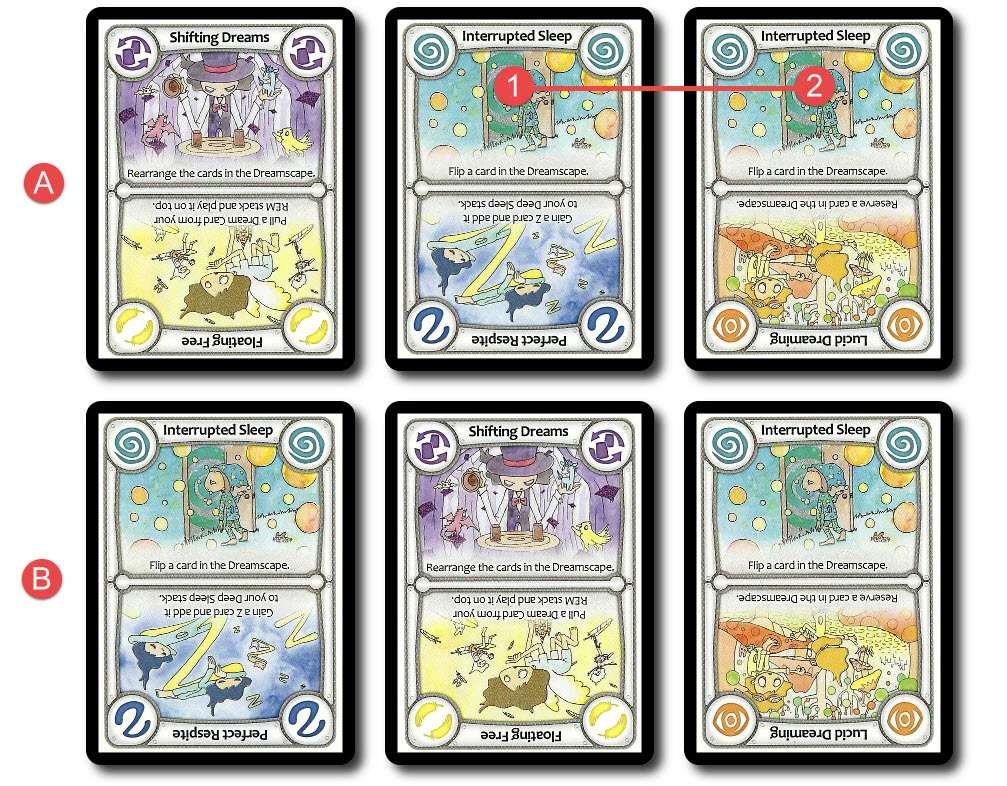
When the Continuous Dreaming score is calculated, subtract from it 1 point for every Z card the player has in their Deep Sleep stack. The resulting number is the player’s score for the game. The player with the highest number of points wins the game. In case of a tie, the winner is the one who has a better balance between their REM and Deep Sleep stack.
To learn more about Project Dreamscape, visit the Kickstarter campaign.
Final Word
The Child Geeks were not the strongest players, forgetting more times than not what cards they had collected. This resulted in some rather small chains, but the ability to rotate cards during final scoring helped many Child Geeks gain points they most likely didn’t consider. Some of our Child Geeks even thought that this was the only way to score points. The older Child Geeks understood the importance of managing what Dream cards went into their REM stacks. They also did a very good job of timing the purchase of new Dream cards. According to one Child Geek, “You really have to think about what cards you want to get. You can’t just collect 1 card. You have to collect 2 or more and then figure when is the best time to collect them.” The Child Geek hit the nail right on the proverbial head. As the cards are collected, they are added to the REM stack where they might or might not do the player any good. The younger Child Geeks found this difficult to think about and ultimately didn’t care to. According to one younger Child Geek, “I think it’s more fun to collect the cards you want and then try to make points with them afterwards.” It sure is, which left me wondering if I was thinking too hard about the game. As I pondered this, the Child Geeks took a vote and all agreed to approve Project Dreamscape.
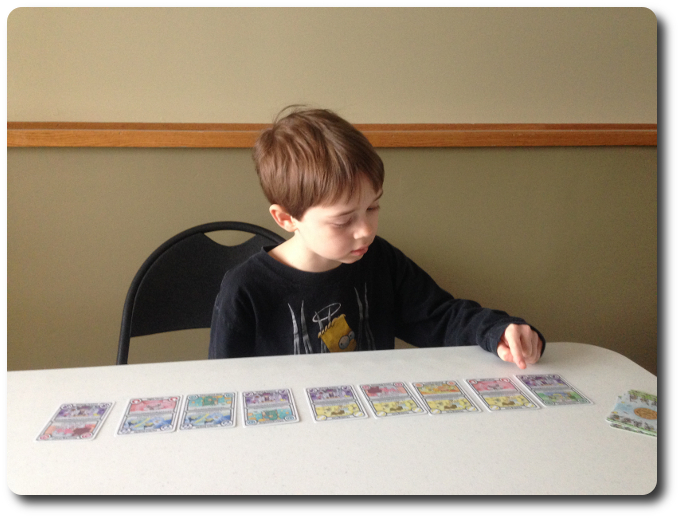
My son counts his unbroken chains while I add his points
The Parent Geeks, whose ranks are made up of casual players and non-gamers, part-time gaming elitists and full-time gaming enthusiasts, all played and loved Project Dreamscape. According to one Parent Geek, “This is a really neat game! You have to purchase cards using cards that hurt you, but they won’t hurt you if you time your purchase correctly to create a really big chain! Wow! Not an easy task, my friend!” No, it sure isn’t, but the game’s difficulty was tempered by the game’s simplistic game play. Being an easy game to learn allowed the players to jump right in with confidence. Even though the games were tough to win, they never felt like they couldn’t play the game or understand how it was unfolding. As one Parent Geek put it, “The most impressive thing about this game is that I am constantly amazed how often I think I have a big chain only to discover I don’t. Makes me feel a bit frustrated, but my frustration is not towards the game. I’m not happy with myself.” While the goal of the game is most certainly not to make players feel inadequate in any way, one thing is for certain. It can. The Parent Geeks liked the challenged and never backed down, however. They unanimously voted to approve Project Dreamscape in between games and bouts of mock self-loathing.
The Gamer Geeks, by and large, don’t get excited about card games. There are always exceptions, though, and Project Dreamscape was one of them. Despite their best effort, the Gamer Geeks could not force themselves to dislike this strategic set collecting card game. According to one Gamer Geek, “There’s more to this card game than you first expect. You have to balance your buying power with your points which you only get if you build your chain right. It offers an excellent challenge.” Another Gamer Geek said, “I thought the Dream type powers would be hokey at first, but they play well within the game’s theme and do a great deal to help the players manipulate the cards. I’m impressed.” When all the games were over, the Gamer Geeks voted to approve Project Dreamscape, finding it to be a surprisingly deep and strategic set collecting card game that challenged a player, while at the same time entertained them.
All of the Dream types are useful and can be leverage to give a player an advantage. Since every Dream card has 2 different Dream types, a player is never left without a choice. In my opinion, the one Dream type that should always be used is Lucid Dreaming. This Dream type is crazy powerful both during the game and at the end, allowing the player to take any Dreamscape card temporarily out of play. But Lucid Dreaming goes one step further and allows the player to hold the Dream card indefinitely or purchase it for only 1 Z card, giving the player a timing and buying advantage.
This little card game made me think. Not so much what I was doing, but how I was doing it and when. Reviewing your REM stack is a must. Failure to do so will result in some very poor points. There were a few games where players didn’t even break even, having more Z cards in their Deep Sleep stack than points in their REM stack. That smarts. What hurts even more is realizing you accidentally broke a chain by 1 card. Thankfully, when the REM stacks are revealed, players have 1 last opportunity to make as many points as they can be rotating their Dream cards. I have always been surprised by a few extra chains I didn’t realize I accidentally made. And by “accidentally” I mean “totally on purpose”.
Small, portable, and challenging, Project Dreamscape engaged each of our players and kept them hooked. Each game provided new insight on new ways to manipulate and organize the Dream cards, mess with opponents, and create killer combos. Project Dreamscape is a game you can learn how to play in 5 minutes and take all afternoon to work out the many different ways to win. Now that’s a good game. Do sit down and play this card game when the opportunity presents itself.
This is a paid for review of the game’s final prototype. Although our time and focus was financially compensated, our words are our own. We’d need at least 10 million dollars before we started saying what other people wanted. Such is the statuesque and legendary integrity of Father Geek which cannot be bought except by those who own their own private islands and small countries.



